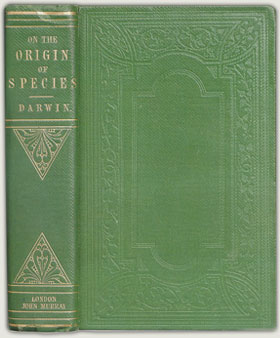Highlights

DARWIN, Charles (1809-1882)
On the Origin of Species by Means of Natural Selection,
or the Preservation of Favoured
Races in the Struggle
for Life.
London: John Murray, 1859
 F
F
irst edition of what is possibly the most influential scientific work of the nineteenth century and the most influential biological work ever written. Darwin had assimilated the researches and observations from his five years as naturalist aboard the survey ship H.M.S. Beagle into the essential formulation of his theory of natural selection more than two decades before On the Origin of Species appeared, but he may not have published his revolutionary theory during his lifetime had not Alfred R. Wallace independently come to a nearly identical conclusion about the transmutation of species. After Wallace's paper "On the Tendency of Varieties to Depart Indefinitely from the Original Type" was printed, however, Darwin rushed to prepare for publication an epitome of the "big species book" that he had been working on since 1856. Originally conceived as a work that might be printed on four or five sheets of paper. On the Origin of Species evolved during the eight months of its writing into a volume of nearly 500 pages. The final scope of presentation prompted Darwin to abandon plans for his "big book," although he salvaged much of the first part of the manuscript for The Variation of Animals and Plants under Domestication, published in 1868.
The entire text of the book is essentially an introduction to, and amplification of, the iconoclastic thesis that Darwin abstracts at the beginning of charter 4: "many more individuals are born than can possibly survive… individuals having any advantage, however slight, over others, would have the best chance of surviving and procreating their kind… any variation in the least degree injurious would be rigidly destroyed. This preservation of favourable variations and the rejection of injurious variations, I call Natural Selection." Origin of Species caused an immediate sensation. Of the first edition of 1250 copies, fifty-eight were distributed by Murray for review, promotion, and presentation and Darwin reported that the balance was sold out on the first day of publication.

